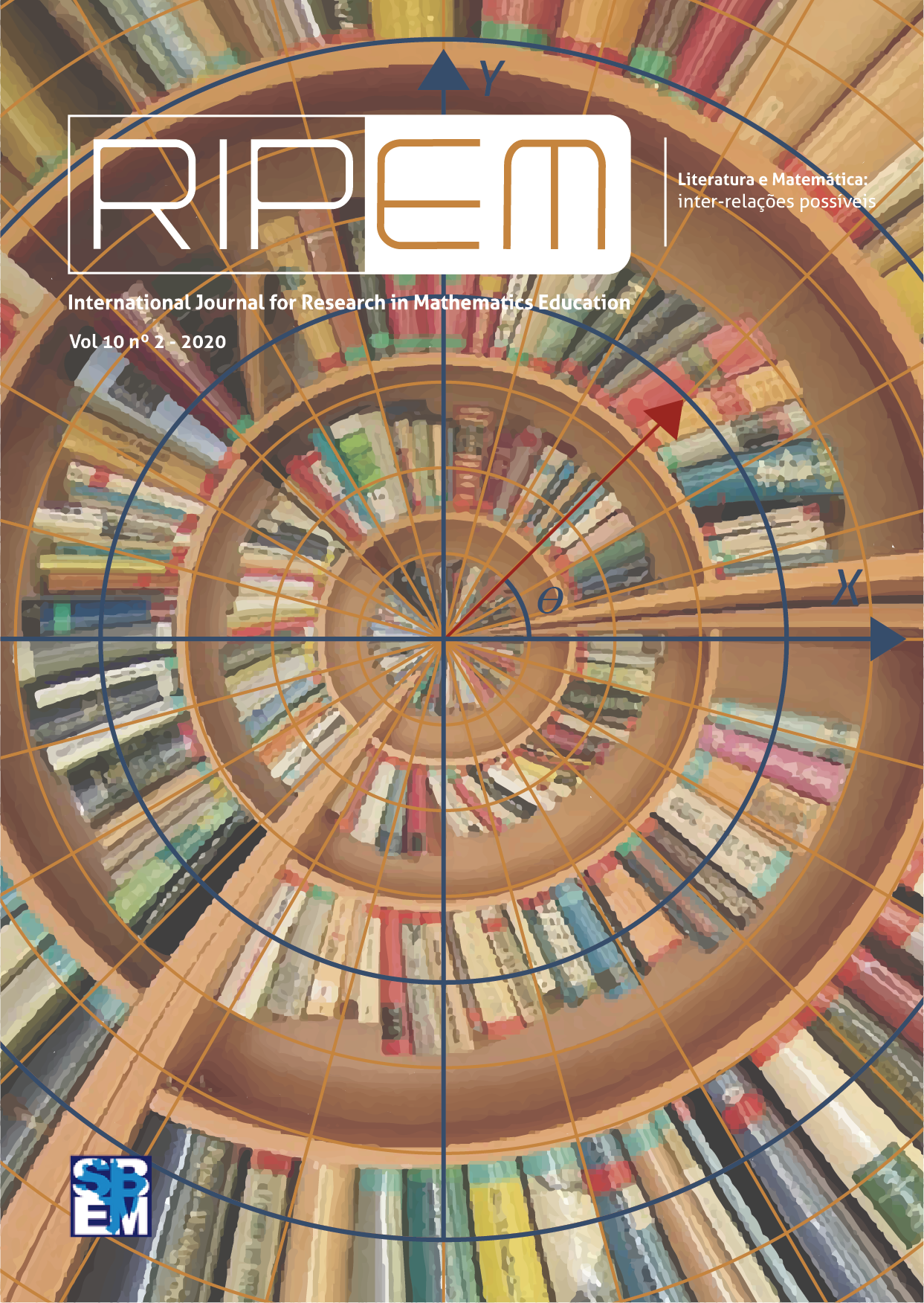Counting with Alice
DOI:
https://doi.org/10.37001/ripem.v10i2.2173Palavras-chave:
Lewis Carroll, Alice, Identity, Arithmetic, NotationResumo
There are many mathematical references in Lewis Carroll’s two tales for children: Alice’s Adventures in Wonderland (1865) and Through the Looking-Glass (1872). Many critics suggested that Carroll inserted hidden meanings in those passages. We rather consider them as part of the story’s setting and narrative. Yet, those passages may be interpreted and used as convenient to illustrate mathematical ideas. In this paper, we consider two passages from the Alice tales that relate to arithmetic, and we discuss them in relation to issues of personal identity, mathematical certainty, the role of notations and the processes of composition and decomposition in mental calculation. Hence, we show how literary texts can be used to convey ideas related to mathematics, mathematical culture and mathematical education. We conclude on the importance of mathematical writings as literary texts.
Downloads
Referências
Abeles, F. F. (2007). Lewis Carroll’s visual logic. History and Philosophy of Logic, 28(1), 1-17.
Abeles, F. F. (2017). On the truth of some new mathematical ideas in Alice’s Adventures in Wonderland. The Carrollian, 29, 3-20.
Abeles, F. F. (2019). Charles L. Dodgson’s work on trigonometry. Acta Baltica Historiae et Philosophiae Scientiarum, 7(1), 27-38.
Abeles, F. F., & Moktefi, A. (2011). Hugh MacColl and Lewis Carroll: crosscurrents in geometry and logic. Philosophia Scientiae, 15(1), 55-76.
Alexander, P. (1944). Logic and the humour of Lewis Carroll. Proceedings of the Leeds Philosophical and Literary Society: Literary and Historical Section, 6(1), 551-566.
Bartley III, W. W. (Ed.) (1986). Lewis Carroll’s Symbolic Logic. New York: C. N. Potter.
Carroll, L. (1885). A Tangled Tale. London: Macmillan.
Carroll, L. (1894). A logical paradox. Mind, 3(11), 436-438.
Dodgson, C. L. (1885). Euclid and his Modern Rivals. London: Macmillan.
Dodgson, C. L. (1890). A New Theory of Parallels. London: Macmillan.
Dutilh Novas, C. (2012). Formal Languages in Logic. Cambridge: Cambridge University Press.
Gardner, M. (Ed.) (2001). The Annotated Alice by Lewis Carroll: The Definitive Edition. London: Penguin Books.
Heath, P. (Ed.) (1974). The Philosopher’s Alice. London: Academy Editions.
Hudson, D. (1958). Lewis Carroll. London: Longmans, Green & co.
Leinhardt, G., Putnam, R., & Hattrup, R. A. (Eds.) (1992). Analysis of Arithmetic for Mathematics Teaching. Hillsdale, N. J.: Lawrence Erlbaum.
MacColl, H. (1896). Review of Lewis Carroll’s Symbolic Logic. The Athenaeum, 3599, 520-521.
Marion, M., & Moktefi, A. (2014). La logique symbolique en débat à Oxford à la fin du XIXe siècle : les disputes logiques de Lewis Carroll et John Cook Wilson. Revue d’Histoire des Sciences, 67(2), 185-205
Moktefi, A. (2007). Lewis Carroll and the British nineteenth-century logicians on the barber shop problem. Proceedings of The Canadian Society for the History and Philosophy of Mathematics, 20, 189-199.
Moktefi, A. (2013). Beyond syllogisms: Carroll’s (marked) quadriliteral diagram. In A. Moktefi, & S.-J. Shin (Eds.), Visual Reasoning with Diagrams (pp. 55-71). Basel: Birkhäuser.
Moktefi, A. (2015a). Is Euler’s circle a symbol or an icon?. Sign Systems Studies, 43(4), 597-615
Moktefi, A. (2015b). On the social utility of symbolic logic: Lewis Carroll against ‘The Logicians’. Studia Metodologiczne, 35, 133-150
Moktefi, A. (2017). Diagrams as scientific instruments. In A. Benedek, & A. Veszelszki (Eds.), Virtual Reality – Real Visuality (pp. 81-89). Frankfurt am Main: Peter Lang.
Moktefi, A. (2019). Is it disgraceful to present a book of mathematics to a Queen?. The Mathematical Intelligencer, 41(1), 42-50.
Moktefi, A., & Abeles, F. F. (2016). The making of ‘What the Tortoise said to Achilles’: Lewis Carroll’s logical investigations toward a workable theory of hypotheticals. The Carrollian, 28, 14-47.
Moktefi, A., & Edwards, A. W. F. (2011). One more class: Martin Gardner and logic diagrams. In M. Burstein (Ed.), A Bouquet for the Gardener: Martin Gardner Remembered (pp. 160-174). New York: The Lewis Carroll Society of North America.
Montoito, R., & Garnica, A. V. M. (2015). Lewis Carroll, education and the teaching of geometry in Victorian England. Revista História da Educação, 19 (45), 9-27.
Olson, E. T. (2019). Personal identity. In E. N. Zalta (Ed.). The Stanford Encyclopedia of Philosophy, URL = <https://plato.stanford.edu/archives/fall2019/entries/identity-personal/>.
Richards, M. (2015). Charles Dodgson’s work for God. In S. Lawrence, & M. McCartney (Eds.), Mathematicians and their Gods (pp. 191–211). Oxford: Oxford University Press.
Taylor, A. L. (1952). The White Knight. Edinburgh: Oliver & Boyd.
Teichman, J., & Evans, K. C. (1999). Philosophy: A Beginner’s Guide. Oxford: Wiley-Blackwell.
Wells, H. G. (1918). Joan and Peter: The History of an Education. New York: Macmillan.
Whewell, W. (1845). Of a Liberal Education. London: J. W. Parker
Willerding, M. F. (1960). Mathematics through a looking glass. Scripta Mathematica, 5(3), 209-219.
Wilson, R., & Moktefi, M. (Eds.) (2019). The Mathematical World of Charles L. Dodgson (Lewis Carroll). Oxford: Oxford University Press.
Publicado
Como Citar
Edição
Seção

Este trabalho está licensiado sob uma licença Creative Commons Attribution-NonCommercial-NoDerivatives 4.0 International License.








